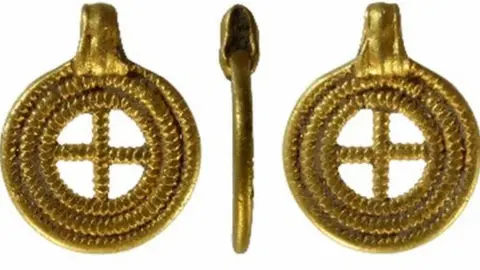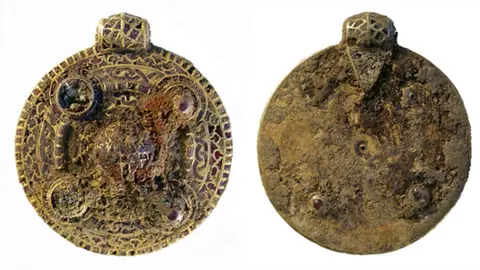Anglo-Saxon gold pendant found in Norfolk declared treasure
 Courtesy of the Portable Antiquities Scheme
Courtesy of the Portable Antiquities SchemeAn Anglo-Saxon gold pendant, found near a site where a similar item worth £145,000 was dug up, probably belonged to a woman of "high social status".
The Winfarthing Pendant was found in 2014 near Diss in Norfolk.
The latest pendant, with a central cross motif, was found in 2017 and it has been declared treasure.
Julie Shoemark, Norfolk's finds liaison officer, said it made a "valuable contribution to our understanding of Saxon society".
 West Stow Anglo-Saxon village
West Stow Anglo-Saxon villageIn 2014, a student found Anglo-Saxon jewellery, including a pendant, at Winfarthing, later valued by the government's Portable Antiquities Scheme at £145,000.
'Immense' social change
The more recently discovered pendant, which features gold bead work and measures 17mm (0.67in) by 13mm (0.5in), is believed to date from the late-6th Century to the mid-7th.
Ms Shoemark, from Norfolk County Council's archaeology department, said: "Like the Winfarthing assemblage, this piece most likely belonged to a high-status lady.
"It dates to an important turning point in Saxon history during the first flowering of Christianity [in England] and is of similar date to the jewellery assemblage from the now famous and nearby Winfarthing burial.
"Male graves of this period appear to be entirely lacking in elaborate jewellery.
"This latest pendant makes a valuable contribution to our understanding of Saxon society, religion and the position of women during a period of immense social and cultural change."
It was declared treasure at an inquest held by the Norfolk Coroner's Office. This means ownership now lies with the Crown.
It will now be valued by the Portable Antiquities Scheme.
 British Museum
British MuseumSimilar items had been found in collections left in Anglo-Saxon graves across the east of England and Kent.
The Winfarthing Pendant, discovered by student-turned-archaeologist Tom Lucking, has recently been on show at The British Library in London.
Treasure experts described it as having "national significance" shortly after it was discovered.

What is treasure?
- Under the Treasure Act 1996, finders of potential treasure in England, Wales and Northern Ireland are legally obliged to notify their local coroner
- An inquest then determines whether the finds constitute treasure
- The act contains a number of definitions of "treasure", including prehistoric objects, coins that contain gold or silver and are at least 300 years old, or more recent valuable objects that have been deliberately hidden
- If the find is declared treasure, the finder must offer it for sale to a museum at a price set by the British Museum's Treasure Valuation Committee
- A reward is then offered to the finders and other relevant parties

